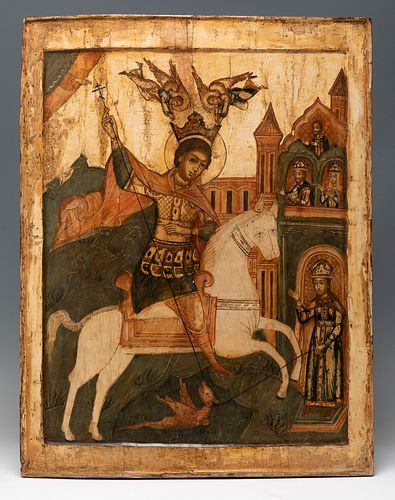Northern Russian icon, 18th century. "St. George fighting the dragon". Tempera and levkas on wood.
Lot 95
About Seller
Setdart Auction House
Carrer Aragó 346
Barcelona
Spain
Setdart Subastas was born in 2004 and is currently the first online art auction in Spain with solidity, prestige and reliability guaranteed by our more than 60,000 users. Setdart has a young, dynamic and enterprising team ready to successfully manage the purchase and sale of art works through custom...Read more
Estimate:
EUR€18,000 - EUR€20,000
$19,565.22 - $21,739.13
Absentee vs Live bid
Two ways to bid:
- Leave a max absentee bid and the platform will bid on your behalf up to your maximum bid during the live auction.
- Bid live during the auction and your bids will be submitted real-time to the auctioneer.
Bid Increments
| Price | Bid Increment |
|---|---|
| EUR€0 | EUR€10 |
| EUR€200 | EUR€25 |
| EUR€500 | EUR€50 |
| EUR€1,000 | EUR€100 |
| EUR€3,000 | EUR€200 |
| EUR€5,000 | EUR€500 |
| EUR€10,000 | EUR€1,000 |
| EUR€20,000 | EUR€2,000 |
| EUR€50,000 | EUR€5,000 |
About Auction
By Setdart Auction House
Nov 3, 2021
Set Reminder
2021-11-03 08:00:00
2021-11-03 08:00:00
America/New_York
Bidsquare
Bidsquare : OLD MASTERS
https://www.bidsquare.com/auctions/setdart-auction-house/old-masters-7786
Setdart Auction House sofia@setdart.com
Setdart Auction House sofia@setdart.com
- Lot Description
Northern Russian icon, 18th century. "St. George fighting the dragon". Tempera and levkas on wood. It presents small restorations. Measurements: 71 x 54 cm. The icon that occupies us represents St. George saving Elisaba, the daughter of the pagan king of Selena, in Libya, who holds the dragon with a strap and is blessed by the king and the queen who witness the scene. By thrusting his spear into the dragon's mouth, St. George frees the city from its clutches, which were blocking the water supply, as well as Elisaba, who had been chosen as a ransom by the dragon. Two angels crown the saint while Christ blesses him. The legend of St. George is one of the most recurrent passages in Christian literature and iconography. The first mentions of St. George as a martyr appear as early as the 5th century, and are initially limited to a specific territory: Cappadocia (the legend says it was his birthplace), Nicomedia and Diospolis (Lydia). According to the first versions of hagiography, George suffered torture at the hands of the Persian king Dadian; this character was later replaced by the historical figure of Emperor Diocletian. In the period after the iconoclastic period, around the 11th century, to the story of George's numerous tortures is added the developed cycle of miracles. It is believed to have been created mainly among Eastern monastic circles. The most popular of the miracles, "The miracle with the dragon", the one depicted on our icon, in the central square. This legend dates back to the oral tradition of the eighth century; in manuscripts it is not recorded for the first time until the twelfth century. However, these dates may find variations in different historical sources. In Russia, the cult of St. George begins to gain popularity around the 11th century, coinciding with the reign of Yaroslav the Wise. In both Byzantine and Russian Orthodox art, depictions of St. George with hagiographic scenes are quite rare and scarce, compared to other popular saints. The curious detail of the present icon is the central scene, which depicts St. George on horseback slaying the dragon. Only in the early Muscovite tradition, and in the Byzantine tradition itself, in the central scene St. George is depicted standing upright and in full body, in all other interpretations of the scene St. George appears like this, as in the present icon. The symbolism of this particular iconography goes back to early Christian beliefs, which form, practically, the basis of all Christianity, of the struggle between good and evil. This is one of the reasons why the theme of St. George is so recurrent throughout history.
- Shipping Info
-
In-house shipping available. Please inquire at admin@setdart.com.
-
- Buyer's Premium



 EUR
EUR CAD
CAD AUD
AUD GBP
GBP MXN
MXN HKD
HKD CNY
CNY MYR
MYR SEK
SEK SGD
SGD CHF
CHF THB
THB
















